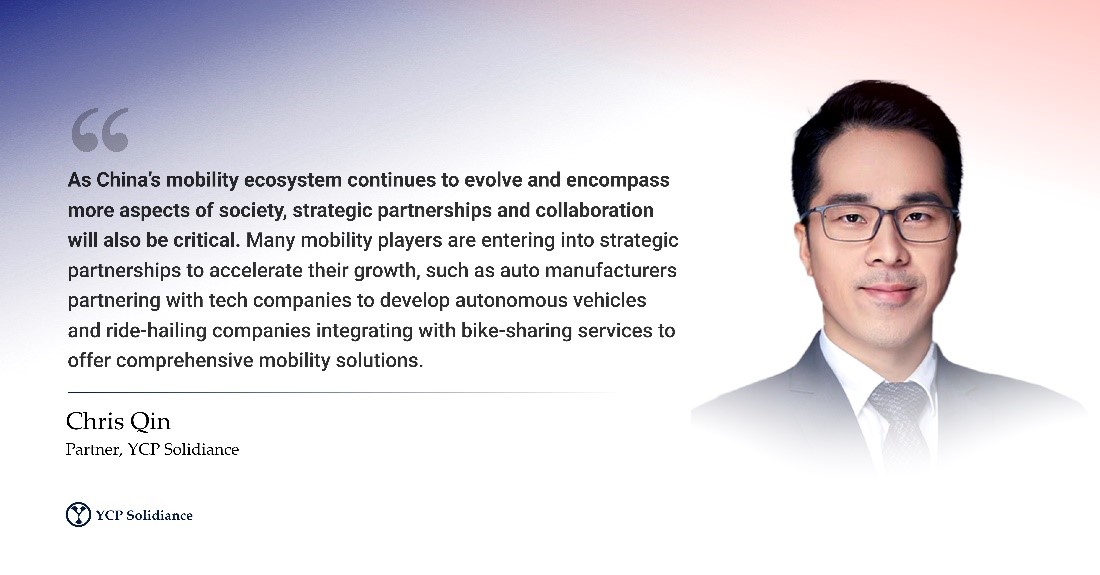Author
Chris Qin
Chris is our Partner based in Shanghai. Chris started his career in global consulting firms where he has worked closely with world Fortune 500 companies and high profile investment banks & PE/VC etc.
In 2022, China sold over 23 million vehicles with an impressive 10% year-over-year growth, solidifying its position as the leading car market globally and in Asia. Meanwhile, China is also expected to lead in the shared mobility market in 2023 with a projected revenue of USD 357 billion.
Such data indicates the immense potential of China’s mobility sector, which is undergoing a transformative period of growth with several potential investment opportunities for stakeholders at all levels.
We asked YCP Solidiance Partner Chris Qin, who is based in our Shanghai office, for insight into China’s mobility industry. With his rich experience in assisting companies in the automotive industry, including market entry strategy, 4S channel optimization, seller-side FA, and competitor intelligence, he shared his insights into the evolution of China's mobility market, the latest industry trends, and how these developments will inform market strategy in the coming years. He also has experience across relevant industries like battery technology & solutions, smart sensors, and car electronics.
Before discussing the current state of mobility in China, what did the industry’s landscape look like in the past? How has it evolved into the global powerhouse it is today?
Over the years, China’s mobility sector has undergone significant transformations in several areas, evolving from traditional bicycles to cars, high-speed rails, shared mobility services, electric vehicles, and now autonomous driving. The government's policies, technological advancements, and changing consumer preferences have been the key drivers of this evolution.
Previously, bicycles were the primary mode of transportation, especially in urban areas. However, there was a massive shift towards car ownership due to economic growth, a rising middle class, and increased purchasing power. This period saw the development of China's domestic auto industry, eventually leading to China’s transformation into the industry leader that it is today.
In the last decade, China also emphasized growth in other areas of mobility to create a holistic foundation. For instance, the mid-2000s saw the inception of China's high-speed rail network, which has now become one of the most extensive in the world.
Such development has paved the way for mobility’s accelerated growth in China and the innovations that are happening presently, including examples like the rapid growth of electric vehicles (EVs), the integration of innovative ride-sharing services as part of the urban mobility mix, albeit in a new, technologically advanced avatar, and the development of autonomous driving technology.
Considering the evolution of China’s mobility market, what is the current state of mobility? How have past developments impacted the landscape at present?
The rapid evolution of mobility in China has created a dynamic ecosystem with a diverse range of players that dominate different segments. The current ecosystem primarily comprises public transportation, private vehicles, ride-sharing services, bike-sharing programs, and electric vehicles.
Despite the innovation of other segments and the shift toward ownership of private vehicles, public transportation is still a significant sub-sector, especially in densely populated urban areas. The current development of public transportation primarily focuses on leveraging smart technology, specifically magnetic levitation trains, robot or autonomous vehicles, and artificial intelligence in public transportation operations, to name a few.
In line with how consumer preferences constantly evolve, there has also been a notable shift from public transportation to ride-sharing services. Currently, the segment is led by companies like Didi, which has gained significant traction. Didi, often regarded as China's Uber, dominates the ride-hailing market and has diversified into other mobility services like food delivery. Though Didi is still the most significant player, the company was fined by China's cybersecurity regulator in 2021, creating market space for second tier players like T3, Caocao, and aggerated platforms like Baidu, Meituan, and Gaode.
Similarly, bike-sharing is also becoming important in China’s mobility ecosystem, with companies like Halo, Meituan, and Qingju leading the charge. These services are especially popular in congested city centers, offering convenient and eco-friendly mobility solutions. Additionally, the emergence of bike-sharing services solves the “last kilometer” problem for many citizens, providing urban travelers with an efficient, accessible, and sustainable mode of transportation to reach their destinations.
Another significant segment in mobility is electric vehicles, where growth is driven by the Chinese government’s push for clean energy adoption. The Chinese EV market is especially attractive to investors as Chinese automotive players are integrating innovative technologies, such as advanced assisted driving systems, further bolstering China’s position against competitors. China is currently the largest EV market globally, with domestic manufacturers like BYD, NIO, and international players like Tesla leading the way.
Given the progress of China’s mobility market in the past and present, what is the industry’s future trajectory? Are there any specific trends that should be expected?
With the strong foundation that has been built throughout the years, China’s mobility industry is well-positioned for further success in the future. In the coming years, the industry as a whole, mobility players, and their strategies will likely be shaped by the development of these segments:
- Electric Vehicles (EVs): While EV development is already in progress, the market's growth is expected to continue, driven by government policies, increasing consumer acceptance and mindfulness of sustainability, and advancements in battery technology. By 2025, China aims to have new energy vehicles, including EVs, comprise 20% of its new car sales, indicating a promising future for this segment.
- Autonomous Driving: With advancements in AI, machine learning, and the Internet of Things (IoT), autonomous driving is becoming increasingly viable. China's tech giants like Baidu and Didi are investing heavily in this area. It's predicted that by 2030, a large proportion of new vehicles sold in China will be equipped with some level of autonomous driving capability. However, regulatory challenges, technical issues, and public acceptance are potential barriers.
- Shared Mobility: The trend of shared mobility continues to grow, as evidenced by the widespread adoption of ride-hailing and bike-sharing services. The main drivers are urbanization, congestion, and the emphasis on sustainability. Depending on government policy, regulatory issues and profitability of business models could be challenges.
- Connectivity and Digitalization: Similar to shared mobility, the integration of IoT, AI, and machine learning is leading to the growth of connected and smart vehicles. This trend is driven by the increasing digitalization of society and the public sector’s push for smart cities. This could lead to the growth of services such as in-car entertainment and e-commerce, vehicle-to-vehicle communication, and other IoT-enabled services. Mobility players must address data privacy and cybersecurity concerns to implement mobility in these contexts successfully.
- Mobility as a Service (MaaS): The demand for integrated mobility solutions is growing in Asia, China, and worldwide. Digital platforms are being used to integrate various transportation services. The main drivers are the increasing adoption of digital technology and the need for efficient and convenient mobility solutions. Cooperation among different service providers and data privacy will be essential to success.
With these future trends in mind, how should mobility players position themselves for success? What advice can you offer to industry players?
The success of mobility players in the coming years will be determined by several factors, with technology adoption, partnerships, and having comprehensive knowledge about China’s mobility landscape being the most critical considerations.
Sustaining technology adoption in mobility should be a point of emphasis. Mobility players must harness rapid technological advancement to create innovative mobility solutions. Such a trend can already be seen as AI and machine learning are being used to develop autonomous driving technology. Another example is the innovation of advanced battery technology in deploying new energy vehicles (NEVs), including EVs.
Further, stakeholders should expect mobility players to continue to leverage related tech solutions, like data utilization. With vast data available, companies can identify trends through advanced data analytics, improving operational efficiency and informing strategic decisions. More importantly, deploying this approach will enable mobility players to understand consumer preferences and gain data-driven insight. For instance, ride-hailing and bike-sharing companies can use data to optimize routes and manage their fleet effectively.
As China’s mobility ecosystem continues to evolve and encompass more aspects of society, strategic partnerships and collaboration will also be critical. Many mobility players are entering into strategic partnerships to accelerate their growth, such as auto manufacturers partnering with tech companies to develop autonomous vehicles and ride-hailing companies integrating with bike-sharing services to offer comprehensive mobility solutions. Likewise, companies should seek to collaborate and align their strategies with the government's policies to ensure long-term success.
For domestic and foreign mobility players alike, comprehensive knowledge of China’s mobility ecosystem will also play a major role in finding success. While the Chinese government has deployed several initiatives to support mobility growth, there are still strict regulations in place, so market strategies should be shaped considering several factors. For example, data privacy and cybersecurity are major regulatory considerations in mobility, as there have been previous instances where millions of users’ data were illegally collected and processed. To properly navigate the mobility market and its nuances, interested parties should tap local mobility players who have already established themselves and have intimate knowledge of the landscape. Combining resources will only stand to benefit players’ journey into mobility.
Overall, China's mobility market shows no signs of slowing down and is expected to maintain its dominance. The future of mobility in China will be shaped by all parties involved– be it the government, private sector players, and even consumers. How parties navigate mobility’s various segments and catalyze growth will be critical to China’s long-term success as a mobility powerhouse.
Chris is our Partner based in Shanghai. Chris started his career in global consulting firms where he has worked closely with world Fortune 500 companies and high-profile investment banks & PE/VC, etc. After that, and prior to joining YCP Solidiance, Chris has been a C-level executive in two multinational corporations for many years, specializing in corporate strategy, investor relations, IPO and M&A strategy, and corporate operation. Chris holds a Bachelor’s degree in Business Administration from Fudan University.






